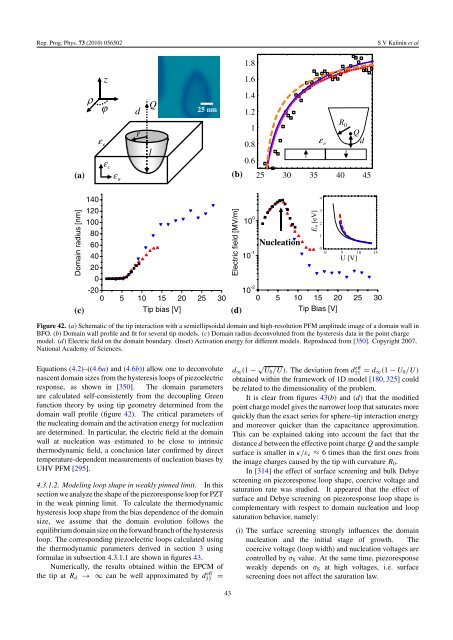Local polarization dynamics in ferroelectric materials
Local polarization dynamics in ferroelectric materials
Local polarization dynamics in ferroelectric materials
Create successful ePaper yourself
Turn your PDF publications into a flip-book with our unique Google optimized e-Paper software.
Rep. Prog. Phys. 73 (2010) 056502<br />
S V Kal<strong>in</strong><strong>in</strong> et al<br />
(a)<br />
z<br />
ρ ϕ Q<br />
d<br />
25 nm 1.2<br />
R<br />
1<br />
0<br />
r<br />
Q<br />
0.8<br />
ε e d<br />
l<br />
0.6<br />
(b) 25 30 35 40 45<br />
ε e<br />
ε c<br />
ε a<br />
1.8<br />
1.6<br />
1.4<br />
Doma<strong>in</strong> radius [nm]<br />
(c)<br />
140<br />
120<br />
100<br />
80<br />
60<br />
40<br />
20<br />
0<br />
-20<br />
0 5 10 15 20 25 30<br />
Tip bias [V]<br />
Electric field [MV/m]<br />
(d)<br />
10 0<br />
10 -1<br />
10 -2<br />
Nucleation<br />
Ea [eV]<br />
0<br />
0 5 10 15<br />
0 5 10 15 20 25 30<br />
Tip Bias [V]<br />
Figure 42. (a) Schematic of the tip <strong>in</strong>teraction with a semiellipsoidal doma<strong>in</strong> and high-resolution PFM amplitude image of a doma<strong>in</strong> wall <strong>in</strong><br />
BFO. (b) Doma<strong>in</strong> wall profile and fit for several tip models. (c) Doma<strong>in</strong> radius deconvoluted from the hysteresis data <strong>in</strong> the po<strong>in</strong>t charge<br />
model. (d) Electric field on the doma<strong>in</strong> boundary. (Inset) Activation energy for different models. Reproduced from [350]. Copyright 2007,<br />
National Academy of Sciences.<br />
4<br />
3<br />
2<br />
1<br />
U [V]<br />
Equations (4.2)–((4.6a) and (4.6b)) allow one to deconvolute<br />
nascent doma<strong>in</strong> sizes from the hysteresis loops of piezoelectric<br />
response, as shown <strong>in</strong> [350]. The doma<strong>in</strong> parameters<br />
are calculated self-consistently from the decoupl<strong>in</strong>g Green<br />
function theory by us<strong>in</strong>g tip geometry determ<strong>in</strong>ed from the<br />
doma<strong>in</strong> wall profile (figure 42). The critical parameters of<br />
the nucleat<strong>in</strong>g doma<strong>in</strong> and the activation energy for nucleation<br />
are determ<strong>in</strong>ed. In particular, the electric field at the doma<strong>in</strong><br />
wall at nucleation was estimated to be close to <strong>in</strong>tr<strong>in</strong>sic<br />
thermodynamic field, a conclusion later confirmed by direct<br />
temperature-dependent measurements of nucleation biases by<br />
UHV PFM [295].<br />
4.3.1.2. Model<strong>in</strong>g loop shape <strong>in</strong> weakly p<strong>in</strong>ned limit. In this<br />
section we analyze the shape of the piezoresponse loop for PZT<br />
<strong>in</strong> the weak p<strong>in</strong>n<strong>in</strong>g limit. To calculate the thermodynamic<br />
hysteresis loop shape from the bias dependence of the doma<strong>in</strong><br />
size, we assume that the doma<strong>in</strong> evolution follows the<br />
equilibrium doma<strong>in</strong> size on the forward branch of the hysteresis<br />
loop. The correspond<strong>in</strong>g piezoelectric loops calculated us<strong>in</strong>g<br />
the thermodynamic parameters derived <strong>in</strong> section 3 us<strong>in</strong>g<br />
formulae <strong>in</strong> subsection 4.3.1.1 are shown <strong>in</strong> figures 43.<br />
Numerically, the results obta<strong>in</strong>ed with<strong>in</strong> the EPCM of<br />
the tip at R d → ∞ can be well approximated by d33 eff =<br />
d ∞ (1 − √ U 0 /U). The deviation from d33 eff = d ∞(1 − U 0 /U)<br />
obta<strong>in</strong>ed with<strong>in</strong> the framework of 1D model [180, 325] could<br />
be related to the dimensionality of the problem.<br />
It is clear from figures 43(b) and (d) that the modified<br />
po<strong>in</strong>t charge model gives the narrower loop that saturates more<br />
quickly than the exact series for sphere–tip <strong>in</strong>teraction energy<br />
and moreover quicker than the capacitance approximation.<br />
This can be expla<strong>in</strong>ed tak<strong>in</strong>g <strong>in</strong>to account the fact that the<br />
distance d between the effective po<strong>in</strong>t charge Q and the sample<br />
surface is smaller <strong>in</strong> κ/ε e ≈ 6 times than the first ones from<br />
the image charges caused by the tip with curvature R 0 .<br />
In [314] the effect of surface screen<strong>in</strong>g and bulk Debye<br />
screen<strong>in</strong>g on piezoresponse loop shape, coercive voltage and<br />
saturation rate was studied. It appeared that the effect of<br />
surface and Debye screen<strong>in</strong>g on piezoresponse loop shape is<br />
complementary with respect to doma<strong>in</strong> nucleation and loop<br />
saturation behavior, namely:<br />
(i) The surface screen<strong>in</strong>g strongly <strong>in</strong>fluences the doma<strong>in</strong><br />
nucleation and the <strong>in</strong>itial stage of growth. The<br />
coercive voltage (loop width) and nucleation voltages are<br />
controlled by σ S value. At the same time, piezoresponse<br />
weakly depends on σ S at high voltages, i.e. surface<br />
screen<strong>in</strong>g does not affect the saturation law.<br />
43
















